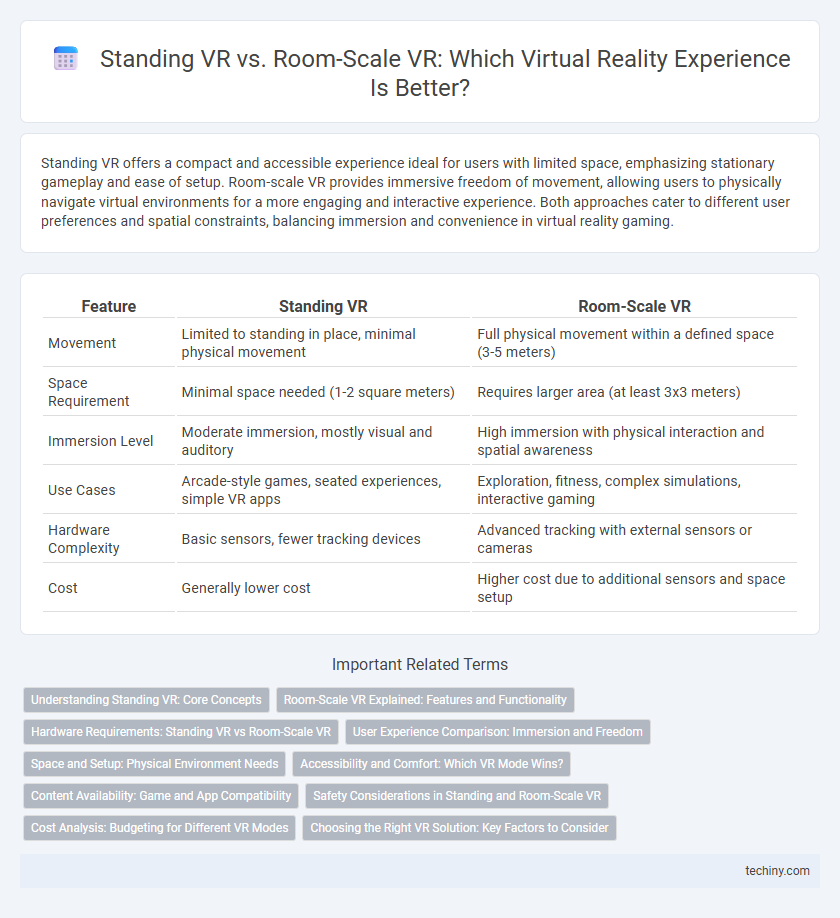Standing VR offers a compact and accessible experience ideal for users with limited space, emphasizing stationary gameplay and ease of setup. Room-scale VR provides immersive freedom of movement, allowing users to physically navigate virtual environments for a more engaging and interactive experience. Both approaches cater to different user preferences and spatial constraints, balancing immersion and convenience in virtual reality gaming.
Table of Comparison
| Feature | Standing VR | Room-Scale VR |
|---|---|---|
| Movement | Limited to standing in place, minimal physical movement | Full physical movement within a defined space (3-5 meters) |
| Space Requirement | Minimal space needed (1-2 square meters) | Requires larger area (at least 3x3 meters) |
| Immersion Level | Moderate immersion, mostly visual and auditory | High immersion with physical interaction and spatial awareness |
| Use Cases | Arcade-style games, seated experiences, simple VR apps | Exploration, fitness, complex simulations, interactive gaming |
| Hardware Complexity | Basic sensors, fewer tracking devices | Advanced tracking with external sensors or cameras |
| Cost | Generally lower cost | Higher cost due to additional sensors and space setup |
Understanding Standing VR: Core Concepts
Standing VR refers to virtual reality experiences designed for users who remain in a fixed position, enabling interaction through head and hand movements without requiring large physical spaces. This mode leverages sensor-based tracking to deliver immersive environments by mapping user inputs in confined areas, optimizing for smaller setups and minimizing space constraints. Understanding the core concepts of standing VR involves recognizing its emphasis on intuitive motion capture and spatial awareness within a limited footprint, differentiating it from room-scale VR that demands larger physical movement.
Room-Scale VR Explained: Features and Functionality
Room-scale VR offers immersive experiences by allowing users to physically move within a designated play area, typically 10 by 10 feet or larger, tracked by external sensors or base stations. This setup enables natural interactions with virtual environments, supporting walking, crouching, and object manipulation, enhancing spatial awareness and presence. Key features include precise positional tracking, real-time motion detection, and seamless integration with VR controllers for intuitive control and navigation.
Hardware Requirements: Standing VR vs Room-Scale VR
Standing VR requires a headset with basic positional tracking and often uses a single base station or inside-out tracking, demanding lower hardware specifications compared to room-scale VR. Room-scale VR necessitates multiple base stations or external sensors to track movement across a larger physical space, increasing the need for robust CPU and GPU performance to manage real-time rendering and accurate spatial feedback. The higher hardware requirements of room-scale setups support immersive locomotion and interaction but involve greater setup complexity and spatial considerations.
User Experience Comparison: Immersion and Freedom
Standing VR offers a more stationary user experience, limiting physical movement to a small area which can reduce immersion but simplifies setup and reduces space requirements. Room-scale VR provides full-body tracking and allows users to physically walk around within a defined space, greatly enhancing the sense of presence and freedom for a more immersive experience. The trade-off between the two lies in balancing spatial freedom and physical activity, with room-scale VR delivering superior immersion through natural movement while standing VR enhances accessibility and comfort.
Space and Setup: Physical Environment Needs
Standing VR requires minimal physical space and a simple setup, making it ideal for small rooms or limited environments. Room-scale VR demands a larger, unobstructed area to allow free movement, typically at least 2 meters by 2 meters, with multiple sensors or base stations for accurate positional tracking. Proper calibration and boundary configuration are essential in room-scale setups to ensure user safety and immersive experience.
Accessibility and Comfort: Which VR Mode Wins?
Standing VR offers greater accessibility for users with limited space or mobility, requiring only a fixed position without extensive movement. Room-scale VR enhances immersion and comfort by allowing natural physical navigation, reducing motion sickness for many users through intuitive spatial interaction. User preference varies, but standing VR generally wins in accessibility while room-scale VR leads in overall comfort during immersive experiences.
Content Availability: Game and App Compatibility
Standing VR offers broad compatibility with a wide range of games and apps designed for minimal movement, ensuring easy access to countless titles across major platforms. Room-scale VR supports more immersive experiences by enabling physical navigation, but its content library is narrower as developers tailor apps specifically for spatial interactions and larger play areas. Game developers continually expand room-scale VR offerings, yet standing VR remains the dominant format due to its extensive content availability and lower hardware requirements.
Safety Considerations in Standing and Room-Scale VR
Standing VR limits physical movement to a confined area, reducing the risk of collisions with real-world objects, which enhances user safety in smaller spaces. Room-scale VR enables expansive tracking and immersive navigation but requires extensive clearance and careful setup to prevent accidents and ensure boundaries are respected. Proper boundary systems and user awareness are critical to minimizing falls, bumps, and entanglement in cables during room-scale VR experiences.
Cost Analysis: Budgeting for Different VR Modes
Standing VR setups typically require a single headset and minimal external sensors, resulting in lower initial costs and reduced space requirements ideal for budget-conscious users. Room-scale VR demands multiple sensors or base stations, increasing hardware expenses and setup complexity, alongside the need for a larger dedicated play area. Evaluating cost differences helps users determine the best VR mode aligned with their space availability and financial constraints.
Choosing the Right VR Solution: Key Factors to Consider
Choosing between standing VR and room-scale VR depends on available space, budget, and intended use cases. Standing VR offers a compact setup ideal for limited spaces and simpler interaction, while room-scale VR provides full-body motion tracking for immersive experiences but requires a larger play area and higher cost. Evaluate user comfort, content compatibility, and hardware requirements to select the VR solution that best aligns with your goals.
standing VR vs room-scale VR Infographic

 techiny.com
techiny.com